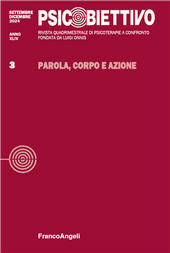L'enactment in psicoterapia
33-45 p.
Nella relazione terapeutica, l'enactment rappresenta un'opportunità per il clinico di entrare in contatto con le memorie traumatiche del paziente. Da distinguere dalla relazione di transfert e controtransfert, l'enactment viene considerato come una messa in atto in cui sensazioni, emozioni, pensieri e fantasie legate al trauma creano quello che Bromberg ha definito un "bozzolo dissociativo". Oltre agli aspetti psichici coinvolti nell'enactment, gli autori sottolineano, attraverso la lente della teoria polivagale, anche il ruolo del corpo, sostenendo che, durante l'enactment, paziente e terapeuta si trovano in una condizione fisica in cui il corpo è in uno stato di allerta e di protezione, piuttosto che in uno di interazione. [Testo dell'editore].
In the therapeutic relationship, enactment represents an opportunity for the clinician to make contact with the patient's traumatic memories. To be distinguished from the transference and countertransference relationship, enactment is seen as an enactment in which trauma-related feelings, emotions, thoughts and fantasies create what Bromberg called a "dissociative cocoon". In addition to the psychic aspects involved in enactment, the authors also emphasise, through the lens of polyvagal theory, the role of the body, arguing that, during enactment, patient and therapist are in a physical condition in which the body is in a state of alertness and protection, rather than one of interaction. [Publisher's Text].
-
Articoli dello stesso fascicolo (disponibili singolarmente)
-
Informazioni
Codice DOI: 10.3280/PSOB2024-003004
ISSN: 1972-487X
PAROLE CHIAVE
- Enactment, memorie traumatiche, dissociazione, teoria polivagale, transfert e controtransfert, corpo, mente e relazione
- Enactment, traumatic memories, dissociation, polyvagal theory


